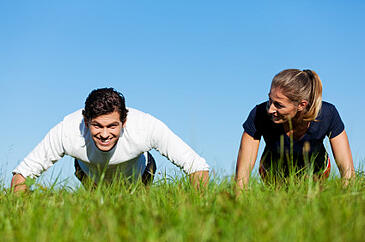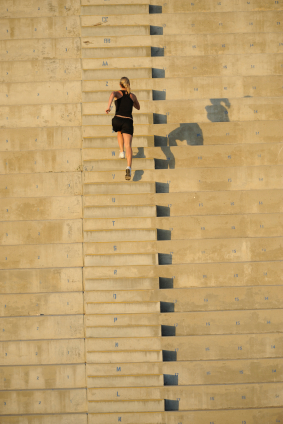You know that magical time when you are riding on the initial motivation wave that comes just after making a fitness resolution. You tell yourself, “This is my year to lose a few pounds and get back into shape,” and you really mean it. Then a few weeks later, the newness wears off, the glitz of new equipment is gone, and along with it your attitude of fun. Your workouts become more of the same. You’ve gotten bored.
There are numerous ways to overcome this bubble so that you actually make your resolution a reality. Here are seven of the best ones which, when used together, can help you keep your fitness resolutions.

Find fun ways to work out that don’t feel like exercise.
You can dance, swim, ride a bike…whatever is fun and doesn’t seem like hard work. Here are some more ideas.
Find a workout partner to share your experiences.
You can find partners at the gym, in the personal training programs, in various groups, and even online. When you have a partner, it not only makes working out fun, but it also adds accountability for everyone involved and a higher commitment level.
Create small competitions between yourself and friends or co-workers.
Create a body-fat or weight-loss challenge or a “who visited the gym the most during the month?” contest. NIFS has a program starting in February to help you get competitive, called Slim It to Win It.
Schedule your workout during times that last-minute excuses are least likely to pop up.
Minimize the chance of finding an excuse not to work out. Convince yourself that the workout is important and anything else can wait.
Celebrate your small accomplishments more often.
Do not celebrate with food! Make a reward chart for yourself with a list of things you want to accomplish and then add a suitable reward. For example, lose five pounds and buy a new CD, or go to the gym at least five times a week for a month and get new shoes. Make the rewards tangible items you want. Make yourself work for the things and you will recognize your achievements and feel motivated to continue.
Create a three-step process to follow:
-
Tell as many people as possible about your goals. The more people you tell, the more people there will be to hold you accountable. You could make an announcement at family reunions, work functions, and parties so people around you will be supportive of your decision and maybe not bring triple chocolate cake to the next function, but rather something healthy to show their support.
-
Write down all of your goals and put them in a place where you can see them frequently.
-
Identify and write down any and all compelling reasons you have for wanting to reach your goals. Examples of compelling reasons include something that moves you personally, such as extending your life so you will be around to see your grandchildren grow up, something as simple as bending over and tying your shoes, being able to climb stairs with groceries easily, and maybe losing enough weight to fit into your clothes again.
7. Reconnect with your compelling reason on a daily and frequent basis so that your mind is focused on always attempting to accomplish your goal.
The more you think about it, the more apt you will be to continue working on the goal. Remember, my fellow NIFS trainers and I are here to help you get there, too. Just give us a call at 317-274-3432.
Written by Thomas Livengood. Click here to meet Thomas and are other NIFS certified Personal Trainers.






 The Sleep and Exercise Connection Researcher Karla Ann Kubitz published findings of a large meta-analysis covering more than 10 years of sleep and exercise studies. The review shows that exercise significantly increases total sleep time and aerobic exercise decreases
The Sleep and Exercise Connection Researcher Karla Ann Kubitz published findings of a large meta-analysis covering more than 10 years of sleep and exercise studies. The review shows that exercise significantly increases total sleep time and aerobic exercise decreases 